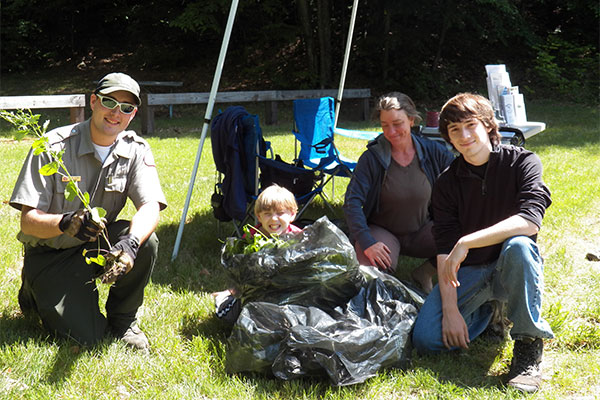
BRATs Make a Dent in Garlic Mustard Population
An edible plant, garlic mustard (Alliaria petiolata) is generally considered a nuisance weed, found along many roadsides and other disturbed areas. A prolific plant, garlic mustard outcompetes and crowds out native plants on the forest floor. While it is unclear whether garlic mustard is a cause or a symptom of forest decline, it is evident that this plant does not promote the health of the forest floor (it exudes chemicals through the soil which impede the growth of other plants, for instance).
In 2014, volunteers with the Black River Action Team (BRAT) pulled garlic mustard at the Springweather Nature Area on Reservoir Road in Springfield, hauling out some 35 pounds of the plant, root and all. This year, the roadside in the nature area seemed clearer where BRAT had pulled in 2014, so volunteers ventured out onto the trails and beyond the original pulling site. They returned with fourteen pounds of plant material in black plastic bags, which were disposed of by the Army Corps of Engineers.
BRAT director Kelly Stettner declares that "it's time to spread the word, not the weed!" Stettner hopes that more people will learn what the plant looks like, identify it in their own yards and neighborhoods, and endeavor to pull it on their own. While garlic mustard does not pose a health threat, it is important to pull the plant properly. The most effective method is to reach down under the "hook" of the root (usually just below the surface of the soil) so the entire root is removed. If disposing of the plant, do not compost it, as it will spread seeds or re-root; instead, place all plant material in heavy black plastic bags and leave in the hot sun for a week or two, to kill the seeds, before placing in the trash.
If mowing, plan to cut before the plant flowers, so you are sure to nip any potential seeds in the bud...literally.
"Garlic mustard makes a terrific pesto," notes Stettner; many recipes can be found online, along with photographs to help people properly identify both first- and second-year garlic mustard plants.
Learn more about the Black River Action Team by logging on to www.BlackRiverActionTeam.org or contacting Kelly Stettner at (802) 738-0456 (Google voice) or [email protected].
(Photo: BRAT volunteers show off their "haul" - photo by Kelly Stettner.)
Email us at [email protected].


